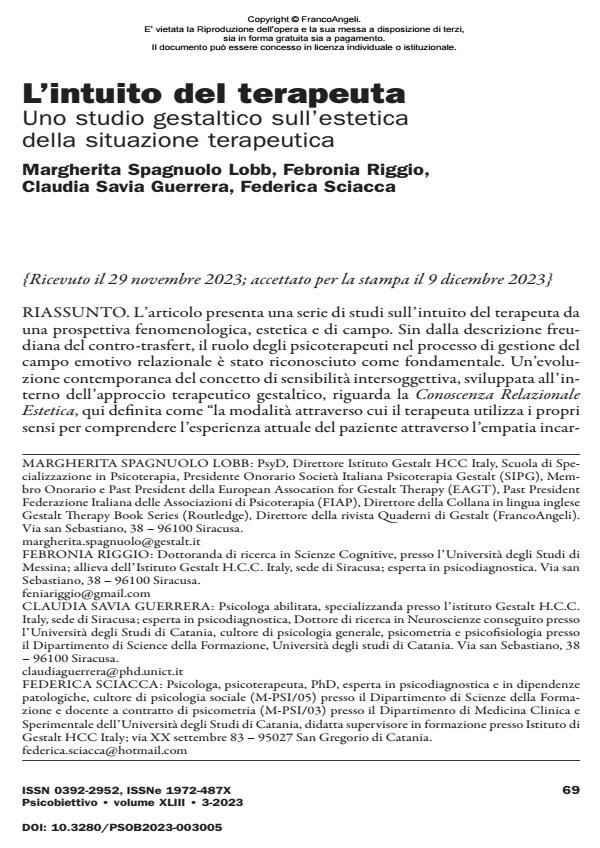Therapist’s intuition. A gestalt therapy study on the aesthetics of the therapeutic situation
Journal title PSICOBIETTIVO
Author/s Margherita Spagnuolo Lobb, Febronia Riggio, Claudia Savia Guerrera, Federica Sciacca
Publishing Year 2024 Issue 2023/3
Language Italian Pages 16 P. 69-84 File size 660 KB
DOI 10.3280/PSOB2023-003005
DOI is like a bar code for intellectual property: to have more infomation
click here
Below, you can see the article first page
If you want to buy this article in PDF format, you can do it, following the instructions to buy download credits

FrancoAngeli is member of Publishers International Linking Association, Inc (PILA), a not-for-profit association which run the CrossRef service enabling links to and from online scholarly content.
This article presents a series of studies on therapist intuition from a phenomenological, aesthetic and field perspective. Since the Freudian description of counter-transference, the role of psychotherapists in the process of managing the relational emotional field has been recognized as fundamental. A contemporary evolution of the concept of intersubjective sensitivity, developed within the gestalt therapeutic approach, concerns Aesthetic Relational Knowledge, defined here as “the way in which the therapist uses his or her senses to understand the patient’s current experience through embodied empathy and resonance”. Three studies on this construct are described, which developed and validated a scale to describe the therapist’s intuition from this specific perspective, the key factors of which are resonance, body awareness, and empathy. The results suggest significant implications for psychotherapist training and supervision, highlighting the importance of body process work and aesthetic relational skills in working with patients.
Keywords: Intuition, Phenomenological Perspective; Gestalt Psychotherapy; Aesthetic Relational Knowledge (ARK); Therapist Training
- La supervisione in psicoterapia della Gestalt Margherita Spagnuolo Lobb, in QUADERNI DI GESTALT 1/2024 pp.7
DOI: 10.3280/qg2024-1oa17950
Margherita Spagnuolo Lobb, Febronia Riggio, Claudia Savia Guerrera, Federica Sciacca, L’intuito del terapeuta. Uno studio gestaltico sull’estetica della situazione terapeutica in "PSICOBIETTIVO" 3/2023, pp 69-84, DOI: 10.3280/PSOB2023-003005